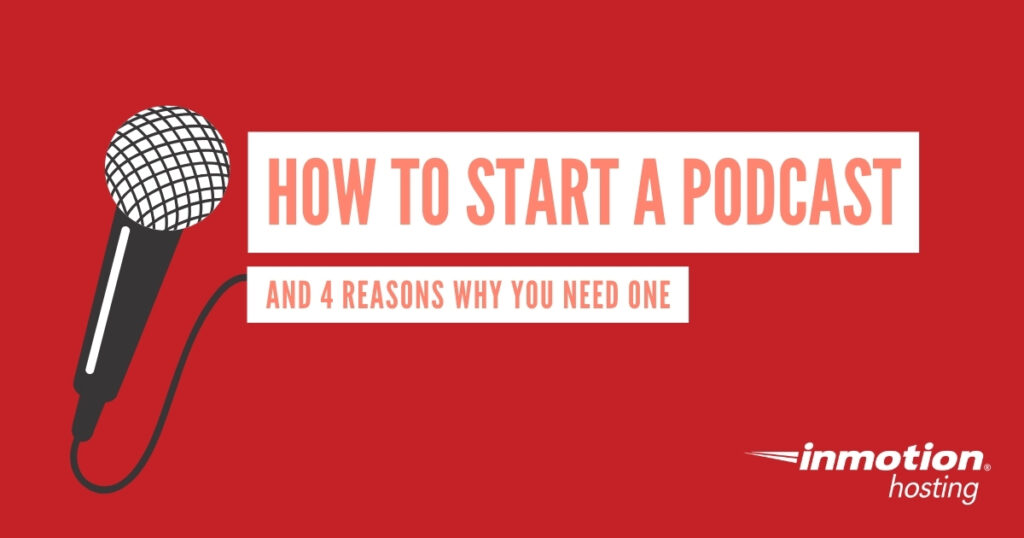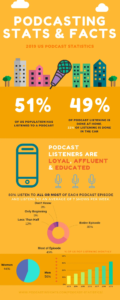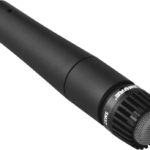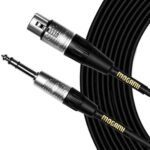
There’s a lot of misinformation regarding how to start a podcast and why it’s worth the effort. Do you need web hosting to podcast? What equipment and software do you need to make podcast? Read on to learn:
Why You Need a Podcast

Not everyone reads. In ten years we’ve evolved from iPod Nanos to affordable smartphones and now cheap, smart feature phones. Tech has enabled us to be more mobile and many prefer content that embraces that. One study showed that over 41% of millennials say they won’t read content if it is too long. Meanwhile, 24% of Americans listen to podcasts weekly. Why?
People can listen on the go – driving to work, running, in the gym, cleaning their home. Vehicles are where 22% of listening takes place. Edison Research found that 36% of Americans listened to podcasts in 2016 – and 64% of them did so on a mobile device.
It’s easier than writing (for some). It takes the average person about 2 hours to write 600 words. That’s around the preferred length of written content for optimal search engine optimization (SEO). A 30-minute podcast can span over 3,000 words – five-times as much in less than half the time.
Repurpose old content. You can discuss updates to popular content based on your web analytics. And podcasts make easy video content. Add an image or an audio spectrum visual to the audio and you have a YouTube or Vimeo video to embed in articles for easy updating.
What You Need to Launch a Podcast
Let’s talk about hardware, software, and wetware.
Equipment Check
A microphone is essential because your internal smartphone or laptop mic has too narrow a frequency range, which causes recordings to sound like old handheld radios. There’s nothing wrong with that sound, but you don’t want to be forced into it every episode. Mics aren’t all expensive. Many popular vloggers have success with microphones that cost less than $200. The Blue Yeti sells for under $150 while their Snowball costs less than $75. For more options and information, including condenser versus dynamic mics, here’s another listicle of popular microphones for podcasting.
The most popular stores for music production gear include Sweetwater, Guitar Center, Sam Ash, and that random pawn shop you ignore en route to the grocery store.

Personally, I like the Shure SM57 dynamic mic because it’s durable and versatile in its ability to handle vocals and various instruments well in studio and live setups. The SM58 is a staple for primarily vocal usage, but they’re both great. Need something for while you’re on the go? Check out the handheld Zoom H4n.
That brings me to the second part of your microphone decision.

An audio interface is required to connect the microphone to your computer unless you purchase an USB mic, like the aforementioned Blue mics. The audio interface connects equipment using XLR and TRS connectors (e.g. non-USB mics and pro-quality studio monitors) to your computer via a single USB or Thunderbolt port.
Obviously, this is another piece of gear you’ll need to carry around for mobile gigs. If you want to record multiple people or expand your setup in the future, you’ll need an interface with multiple inputs/outputs (I/O). If you’re a purely solo act, a 1×1 I/O audio interface or just an USB mic is the cheaper route.

Audio interfaces start at ~$50. The cheapest product I know that works on Windows and Linux is the Lexicon Alpha. It’s plug-and-play. But it doesn’t have phantom power (+48V), a requirement for condenser mics. The Focusrite Scarlett line-up is popular with Windows and Linux users.
The Mixer is likely what you were expecting to see after the mic. USB Mixers are great for complex setups if you want to make adjustments with physical volume faders and pan knobs instead of a mouse. They sync with your digital audio workstation (DAW) (e.g. Pro Tools, FL Studio, Ableton Live) via MIDI to control audio settings post-recording (by default). This means your volume changes are used during the podcast and saved to your DAW file. But the raw recorded files exclude these changes for more flexibility during the editing process.
Some audio interfaces can do mixing but it’s usually just gain as they’re primarily for increasing I/O for your computer. For the solo act, an audio interface with a mic or a USB mic should be enough.
Headphones allow you to listen to guests during conversations without feedback in the mic and hear how the audio will sound to your listeners when editing. Consumer grade headphones from an electronics store will suffice since those and a vehicle will be the most common listening environments for your fans. Similar to audio interfaces, buy what suits your needs. Opt for durable, comfortable headphones as budget allows.
Multimedia Production Software
Audio editors can be as basic as Audacity or robust as the Pro Tools DAW. You can install it on your PC or mobile device. Yes, there are music producers that work on a tablet. All that matters is whether it can:
- Remove noise
- Equalize and normalize audio levels
- Cut, copy, and paste audio snippets
- Compress, limit, and gate for better quality
ID3 tag editors add metadata including title, track number, participant names, and podcast notes. It also allows listeners to see the album art when downloaded. Most audio editing software (including Audacity) and music players can natively do this. If yours can’t, use an ID3 editor. I recommend Kid3.
An image editor is needed to creates artwork that represents your podcast. It must be square with a high resolution between 1400 x 1400 and 3000 x 3000 pixels. The file size should be lower than a megabyte (MB) so applications don’t have to waste resources scaling the image. Without artwork, your show will be rejected by podcast aggregators. If you need one, GIMP is free open source software (FOSS).
A video editor is required for posting podcasts to YouTube. Some can also do screencasting, for those doing “reaction” videos and software reviews. I recommend OpenShot. Like most software referenced here, it’s free.
Online video conference software helps you interview guests and provides a video at the same time. This gives better audio quality than a phone interview. Once you start doing video, you should set up a dedicated interview space too. Acoustic treatment is a whole other topic and overkill for most broadcasters starting out. Just make sure it’s quiet. Jitsi is really user-friendly.
Podcast Hosting
You need a website that can create a validated RSS feed for podcasting platforms. There are multiple ways to do this.
Create a website. WordPress users can use the Blubrry PowerPress plugin. Drupal users have the Podcast (using Views) module. There’s also Podcast Generator, a web application you can install on your web server to manage created podcasts. All you need is the ability to upload audio files to a server and create a RSS feed with the correct format.
You could do that with shared hosting, FileZilla, and a text editor. Whatever you do, make backups.
Launch your web presence quickly and easily with Shared Hosting. Our user-friendly hosting is perfect for everyone, providing the fastest shared hosting experience possible, all powered by cPanel.
Free Domain & SSL Certificates
Unlimited Bandwidth
400+ One-Click Applications
USA & European Data Centers
Use SoundCloud. They have an upload limit in some cases, but this is a way to send podcasts to aggregators like iTunes without Linux server hosting.
Start with YouTube. Forego all the RSS feed configuration work and just upload directly to YouTube. It’s still the second most popular search engine. You probably already have a Google account, so you could save money and time.
Try RSS.com. Remember, all you need is a RSS feed formatted for podcast sites.
Why You Should Use Dedicated Hosting For Your Podcast
If you want total control of your development environment for your podcast, then you may want to choose to invest in dedicated hosting. Here are several reasons why this would be advantageous for your podcast.
Total Freedom
With third-party podcast hosting platforms, you may have unlimited file uploads, but all of your files and resources are basically hosted on someone else’s property.
If you require the freedom and flexibility of your own hosting environment, you must consider a Dedicated Server.
Host Your Podcast Through WordPress
WordPress gives you everything you need to start hosting a podcast. We recommend using the PowerPress Podcasting plugin.
- Log into Your WordPress Dashboard
- Click Plugins
- Install the PowerPress Podcasting plugin
- Fill in your podcast information under Settings
Now you can begin adding podcast content. If you have any questions or comments about this article be sure to leave them below.
How to Start a Podcast
Once you’ve made the appropriate decisions to build your setup, it’s time to produce a podcast. Try to streamline your workflow as much as possible.
It can take a few weeks for your show to be approved and shown on podcast platforms, so schedule your promotion appropriately.
Organize your podcast episode. Will it be an interview? Schedule a quiet time where no one feels rushed. Is it a story to offer an unique perspective on recent news? Have your sources with links ready. Prepare notes for what you’ll cover. Consider creating an intro and outro to add to episodes during editing.
For free background music, you can use Creative Commons (CC) licensed music.
Many podcasters recommend that you have at least three episodes for your launch. One is fine, though. It’s also beneficial to start with an introduction episode to explain:
- The goal of the podcast
- A bit about yourself while being cautious of what personally identifiable information (PII) you don’t want to share
- What your audience should expect
- How they can find you (and subscribe)
- Your expected release schedule
Record the podcast. Ensure you have your favorite beverage nearby and a quiet surrounding. Try to keep your face in the same general position relative to the mic to maintain volume balance. Consider a pop filter to reduce plosives and force a specified distance away from the mic.
Edit the audio. Learn more about compression, limiting, and gating to ensure a balanced volume throughout the podcast. This way, listeners don’t have to constantly turn the audio up or down to hear you. Add intro and outro music, voiceovers, SFX, etc. as needed. Remember to add proper metadata in the ID3 tags of the completed file.
Upload your podcast. Add show notes including the podcast host, guests, and important URLs for SEO purposes to help potential listeners find you. Find your web application options to select an iTunes category. Other podcast sites will respect this setting as well.
Publish your podcast. Afterwards, test your podcast RSS feed with Blubrry’s Cast Feed Validator and W3C’s Feed Validator. Check your podcast generator’s documentation for assistance.
Focus
As you learn more about creating a podcast, you may realize that are many things that can distract your attention from the goal you’re trying to accomplish. Remember to focus on your overall objective! Everyone gets better at recording, editing, and communicating effectively at different rates. There a few things you should keep in mind, though:
- Have a goal (entertainment, education, news, etc.)
- Remember your target audience and how much you’d need to explain certain things to someone of that community
- Use time management to be consistent with episode releases
- Apply SEO for topics you cover and how you explain them in titles
Submit your podcast to iTunes. Occasionally check your Apple account and the most popular podcasting platforms to see when you’re accepted.
Popular Podcasts
This is just a smattering of the podcasts providing expert advice on social media marketing. Each provides you with the opportunity to learn from these professionals and make their experience work with your branding.
The Art of Online Business with Rick Mulready – Rick Mulready brings in social media marketers from some of the biggest companies in the country (including Ford, Redbull, and Whole Foods). In these one-on-one interviews, you will learn about their philosophies on social media and how you can apply this to your own business model.
Social Media Lab – Agorapulse is now putting up $15,000 each month to test out social media practices to see if they are practical and profitable. This is a great idea to start with, but it has also led us to a great podcast called the Social Media Lab where they discuss these projects and report back on how they went. This podcast lets you get the benefit of their expert knowledge and practices without having to spend thousands of dollars yourself.
Social Media Marketing with Michael Stelzner – This podcast, a project of the popular blog Social Media Examiner, has over 400 episodes packed with tons of information. Part of what makes this series so great is that it includes interviews with leading experts in the social media field who give great insights about how you can improve your own social media plan.
Reply All with PJ Vogt and Alex Goldman – Part of the requirement to be a great social media marketer is knowing exactly what is happening with the Internet—new trends, new platforms, and new topics. All of this (and more) is covered on Reply All with in-depth discussions of anything that is online.
The Garyvee Audio Experience – Gary Vaynerchuk is a social media giant who has worked for years to show people that this form of marketing can work best as a conversation between the business and the customers. To promote this idea he has sent over 100,000 individual messages just on Twitter. His podcast brings together over 400 employees on his social media team to show the full range of practices and changes coming to social media.
The Marketing Companion Podcast with Mark Schaefer and Brooke Sellas – When you consider that the two hosts have over 50 years of combined experience, it’s easy to see why this blog is so popular. But it has also been called so good that it’s like a “Snickers bar wrapped in bacon.” The two hosts are data experts who can help you understand the best ways to put data to use in your social media plan.
Learn more about podcasting from our Live Broadcasting Education Channel.
Let us know what questions you still have about podcasting below.
Wow, this article is packed with some seriously valuable insights! I’ve been looking to give my Convert Video to Podcast a boost and the concept of advocacy marketing seems like a game-changer. Building a community of passionate listeners who genuinely advocate for my show could be the missing piece to my promotion strategy. I appreciate the updated information too – it’s great to see that this article is staying current. Can’t wait to implement these strategies and watch my podcast grow. Thanks for sharing!